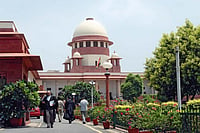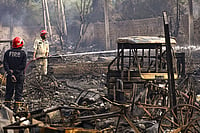Of course, Ghatak connoisseurs will find in this collection most of the concerns underlying his films. The Crystal Goblet and The Road are directly linked to Partition, but in most of the stories the theme of loss of roots, separation and death lingers beneath the narrative. Yet if tragedy is one of the keynotes of his oeuvre, so too is a seething anger, a drive to avenge injustice. This is exemplified in The Deposition, A Fairy Tale, Eyes and Comrade. In these we also see what we understand from his films: that Ghatak was a ruthless realist but one whose violence was tempered by a deep compassion. The very last story, Attack (1969) was written in response to the Naxalite movement. Attack highlights a major concern—the existence of mythical archetypes in the collective unconscious, the need to awaken these. What is left but to attack? he asks. Bengal has been torn apart because we have not articulated the wisdom of our ancient myths—for that the fight is still ahead of us.
Two of the early stories, Solstice and On the Trail of the Milky Way, are about journeys of search and remembrance. In the first, Ghatak, lays bare his restless soul: "The person who has once savoured the nectar of the earth is never free. I feel as if I’m going mad—the same question haunts me over and over again—what is the truth behind nature’s numerous images?" The romantic philosophy of Tagore is much in evidence in Solstice. The second story is in quite another vein: "The fact that he was alive was the final wisdom.... It was not some kind of philosophical wisdom that he gained, but something he felt in his blood." These are surely the thoughts of a dialectical materialist.
Two other important facets of Ghatak’s character and work were a strong sense of irony and a visual poeticism. While the first is especially evident in Touchstone, the story of a clerk who goes mad in his quest to bring the dead back to life, the second is discernible in many of the stories. His very evocative imagery suggests that if he hadn’t become a filmmaker, he would have been a painter. Like all serious film-makers, Ghatak was deeply interested in visual art. His sensitivity to music and sound, which he used with such effect in his films, is also reflected in this collection.
Rani Ray deserves to be commended for her efforts to make Ghatak known as a writer for the first time outside Bengal. Translation is an art in itself, particularly between two languages as different in structure and music as Bengali and English. However, her prose is at times laboured, missing the crispness of contemporary English. It seems she lacked the confidence to be unfaithful to the word in order to convey the spirit of the original.
All writers and translators, no matter how good, need rigorous editorial inputs. These are singularly lacking here. Among other things, the book cries out for a glossary of Indian terms. In its present form, it is unsuitable for distribution on the international market.

























